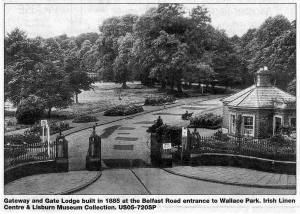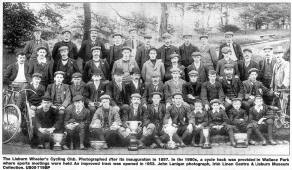
A proud history since being transformed from a meadow
MAJOR EVENTS AND ROYAL VISITS DURING THE PAST 118 YEARS
By KATHRYN MATEER
THE new proposals revealed by the Star for major changes at Wallace Park have revived memories for many people of the history of the famous landmark.
It has hosted many civic and social events in its 118-year history and has been the centre of the town and many of its people during that time.
The Wallace Park was originally named 'The People's Park' when it was given to the residents of Lisburn in 1885 by Sir Richard Wallace.
Following his death in 1890, it was renamed the Wallace Park.
Sir Richard Wallace, who was a local benefactor and a Conservative MP for the Lisburn area from 1873-1885. was also famed as a collector of art.
Sir Richard's name lives on today as, Wallace High, was founded in 1880 by a bequest from the estate of Sir Richard Wallace, as the Lisburn Intermediate and University School.
It was renamed in 1942 in memory of its founder, and they adopted the word 'Esperance' as the school's motto from the Wallace coat of arms.
Five ornate Wallace drinking fountains were once in the town, in various locations including Castle Gardens, Seymour Street, Market Square and Wallace Park. There are also Wallace Fountains in Paris, Rotterdam and Brazil. These fountains were donated by Sir Richard, and the Fountain in Castle Gardens will be included in the current restoration plans.
In 1884 Sir Richard Wallace donated the sum of �4,000 to convert a 26-acre meadow into a Park for the people of Lisburn.
Two of the most striking features of the Park are the gates at the two main entrances. Cast in wrought iron, the traditional Victorian style is reflected in the architecture of buildings around the City, most notably the Town Hall.
The two gate-houses in the park were lived in by the Park Keepers until relatively recently, and are original to the gift of the Park to the town.
Under the current plans, the gate-houses will be restored to their former glory, preserving as many Victorian features as possible.
The 1890's saw the Safety Bicycle become a popular pursuit, after the first cars were introduced in the same decade. So to facilitate the growing trend, a cycle track was developed in the Park.
This track quickly became popular with local cyclists, and the Lisburn Wheeler's Club of 1897 held their races at the track.
Later on, in 1955, this track was improved with banks to become the Park's Velodrome, but due to the expansion of the Cricket Club around 10 years ago, the banks of it are now only just visible.
The Park also played host to the many tennis and football matches of the time.
One or two tennis courts were built in the 1880's, and the first tennis club, which was connected to the Cricket Club, was founded in 1883.
Football was very much the sport of the time, and before the First World War, all districts had their own football teams.
 |
|
Gateway
and Gate Lodge built in 1885 at the Belfast Road
entrance to Wallace Park. Irish Linen Centre &
Lisburn Museum Collection. |
Because Barbour Memorial Playing Fields weren't given to the town until the 1930's, Wallace Park quickly became the top ground due to the luxury of having two pitches.
The Mayor's Parade in the City has become one of the most popular Civic events of recent years, but annual events such as the Scouts and Guides parade days were just as popular in days gone by.
The two groups, along with other local youth organisations, held their parade days in Wallace Park.
In fact in 1945 the Queen, then a teenage Princess Elizabeth, spent the day in Wallace Park reviewing all of the town's Youth Organisations.
Wallace Park's Pond had been a feature of the land long before Sir Richard gave the ground for the Park to be built, and over 100 years later, it remains as one of the best-known features.
The Bandstand is another Victorian feature which is quite typical of that, era and was used regularly. The original Victorian styles of the building remain as they were when it was built.
Despite the many traditional Victorian features of the Park, the additions of more recent times have proved extremely popular.
The children's play area has proved invaluable to families and the upgrading of the concrete to a softer surface, has been welcomed by parents and children alike.
Wallace Park has been an invaluable resource for people throughout generations and it's clear that after a little care and attention, it will be restored to its former glory.
30/01/2004

